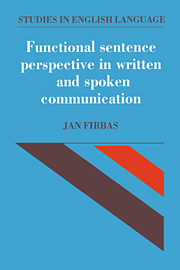Book contents
- Frontmatter
- Contents
- Preface
- List of abbreviations
- Part I Functional sentence perspective in written communication
- 1 Introduction
- 2 The sentence and the carriers of communicative dynamism
- 3 The contextual factor
- 4 The semantic factor
- 5 The theme and the non-theme
- 6 Some special issues of the theory of functional sentence perspective
- 7 Word order and functional sentence perspective
- Part II Functional sentence perspective in spoken communication
- References
- Index
2 - The sentence and the carriers of communicative dynamism
Published online by Cambridge University Press: 19 November 2009
- Frontmatter
- Contents
- Preface
- List of abbreviations
- Part I Functional sentence perspective in written communication
- 1 Introduction
- 2 The sentence and the carriers of communicative dynamism
- 3 The contextual factor
- 4 The semantic factor
- 5 The theme and the non-theme
- 6 Some special issues of the theory of functional sentence perspective
- 7 Word order and functional sentence perspective
- Part II Functional sentence perspective in spoken communication
- References
- Index
Summary
The sentence as a field of relations
Before starting a discussion of the problems of FSP, the question must be answered of how to interpret the relation between the semantic contents and the semantic ties interlinking them within the sentence on the one hand, and the grammatical (syntactic) structure of the sentence on the other; and of how to interpret the relation of this semantic and grammatical complex to FSP. In my approach I have adopted the following assessment of these interrelations.
The communicative needs of the speaker are satisfied through a twofold process: elements of thought – reflecting the extralinguistic reality, concrete or abstract – are denominated by naming units, which are combined to produce sentences. The former process consists in selecting – or if need be, in coining – naming units (and is covered by Mathesius' functional onomatology; see Mathesius 1975); the latter consists in syntactic structuration (and is covered by Mathesius' functional syntax; see ibid.).
Either process involves meaning and form. This may be obvious in regard to the onomatological process, but perhaps less so in regard to the process of syntactic structuration. But the latter does not merely combine forms: as has been emphasized by Reichling (1961: 1) and subscribed to by Dane (1968: 55), syntactic structuration effects a semantic connection, i.e. a connection of meanings. In this way syntactic structure (and grammatical structure in general) is ultimately rooted in meaning (Poldauf 1954). Trost speaks of grammatical structuration effected on a semantic basis (Trost 1962: 268; in Sgall's translation, semantically grounded grammatical articulation; Trost 1987: 147).
- Type
- Chapter
- Information
- Publisher: Cambridge University PressPrint publication year: 1992



